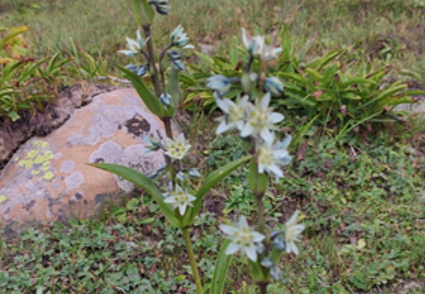Abstract
Swertia kashmirensis subsp. darii (Gentianaceae), a new taxon from Kashmir Himalaya, India is described here with description and photographic illustrations. The new taxon resembles in few morphological characters with congeneric S. kashmirensis, but differs clearly in having basal leaves with apices acute, petals elliptic-oblong, apices obtuse with an apical notch, whitish adaxially and purplish with dull whitish margins abaxially, size of nectaries and fimbriae, carpel ovoid, anthers ovate, capsule ellipsoid, seeds brownish, round with wings narrow.
References
- Banoo, S., Khuroo, A.A. & Ganie, A.H. (2022) Swertia drassensis, a new species from Drass, Ladakh Himalaya. Phytotaxa 571 (2): 219–226. https://doi.org/10.11646/phytotaxa.571.2.8
- Bridson, D. & Forman, L. (1998) Herbarium Handbook. Royal Botanic Gardens, Kew, 261 pp.
- Botanical Survey of India-Flora of India. (2022) Available from: https://efloraindia.bsi.gov.in/ (accessed: 14 September 2023).
- Chunying, X., Tingnong, H. & Dezhu, L. (2002) Floral nectaries in Swertia: Anatomy and morphology. Acta Botanica Yunnanica 24 (3): 359–369.
- Clarke, C.B. (1883) Gentianaceae. In: Hooker, J.D. (Ed.) The Flora of British India. vol. 4. L. Reeve & Co., London, pp. 93–132.
- Dar, G.H & Khuroo, A.A. (2020) Biodiversity of the Himalaya: Jammu and Kashmir State (Vol. 18). Springer Nature, Singapore, pp. 3–26. https://doi.org/10.1007/978-981-32-9174-4
- de Candolle, A.P. (1830) Prodromus Systematis Naturalis Regni Vegetabilis, vol. 4. Parisii, Sumptibus Sociorum Treuttel et Wurtz, 131 pp.
- Díaz, S. & Malhi, Y. (2022) Biodiversity: Concepts, patterns, trends, and perspectives. Annual Review of Environment and Resources 47: 31–63. https://doi.org/10.1146/annurev-environ-120120-054300
- Don, D. (1825) Prodromus Florae Nepalensis, J. Gale, London, 110 pp.
- Don, D. (1825) Prodromus Florae Nepalensis, J. Gale, London, 212 pp.
- Don, D. (1837) Descriptions of Indian Gentianeae. Transactions of the Linnean Society of London 17 (4): 503–532. https://doi.org/10.1111/j.1095-8339.1834.tb00041.x
- Edgeworth, M.P. (1846) Descriptions of some unpublished Species of Plants from North-Western India. Transactions of the Linnean Society of London 20: 44. https://doi.org/10.1111/j.1096-3642.1846.tb00410.x
- ESRI (2013) ArcGIS. Version 10.2. [Computer software]. Available from: https://www.arcgis.com (accessed: 16 February 2024).
- eFlora of China (2008) Available from: http://www.efloras.org/ (accessed: 14 September 2023).
- eFlora of Pakistan (2022) Available from: http://www.efloras.org/ (accessed: 14 September 2023).
- Favre, A., Matuszak, S., Sun, H., Liu, E., Yuan, Y.M. & Muellner-Riehl, A.N. (2014) Two new genera of Gentianinae (Gentianaceae): Sinogentiana and Kuepferia supported by molecular phylogenetic evidence. Taxon 63 (2): 342–354. https://doi.org/10.12705/632.5
- Fu, S.H. (1965) Species et Combinationes Novae Crassulacearum Sinicarum. Acta Phytotaxonomica Sinica 10 (1): 121.
- Hagen, K.B. & Kadereit, J.W. (2002) Phylogeny and flower evolution of the Swertiinae (Gentianaceae-Gentianeae): homoplasy and the principle of variable proportions. Systematic Botany 27: 548–572.
- Ho, T.N. & Liu, S.W. (1980) New taxa of Swertia L. from China. Acta Phytotaxonomica Sinica 18 (1): 75–85.
- Ho, T.N. & Liu, S.W. (2015) A worldwide monograph of Swertia and its allies. Science Press, Beijing, 430 pp.
- Ho, T.N., Xue, C.Y. & Wang, W. (1994) The origin, dispersal and formation of the distribution patterns of Swertia L. Acta Phytotaxonomica Sinica 32: 525–537.
- Hobern, D., Barik, S.K., Christidis, L., T Garnett, S., Kirk, P., Orrell, T.M., Pape, T., Pyle, R.L., Thiele, K.R., Zachos, F.E. & Bánki, O. (2021) Towards a global list of accepted species VI: The Catalogue of Life checklist. Organisms Diversity & Evolution 21 (4): 677–690. https://doi.org/10.1007/s13127-021-00516-w
- Hooker, J.D. (1887) The Flora of British India, vol. 5. L. Reeve & Co., London, 258 pp.
- Hortal, J., Bello, F.D., Diniz-Filho, J.A.F., Lewinsohn, T.M., Lobo, J.M. & Ladle, R.J. (2015) Seven Shortfalls that Beset Large-Scale Knowledge of Biodiversity. Annual Review of Ecology, Evolution, and Systematics (46): 523–549. https://doi.org/10.1146/annurev-ecolsys-112414-054400
- Islam, T., Khuroo, A.A. & Nawchoo, I.A. (2022) Swertia pahalgamensis (Gentianaceae), a new species from Kashmir Himalaya, India. Phytotaxa 547 (2): 201–207. https://doi.org/10.11646/phytotaxa.547.2.8
- Joshi, K. & Joshi, A. (2008) Swertia L. (Gentianaceae) in Nepal Himalaya: Checklist, phytogeography, ethnobotany and conservation status. Ethnobotanical Leaflets 1: 43.
- Jussieu, A.L. (1789) Genera Plantarum. 141. Parisiis, apud viduam Herissant et Theophilum Barrois. https://doi.org/10.5962/bhl.title.284
- Linnaeus, C. (1753) Species Plantarum. Ray Society, London, 767 pp.
- Nampy, S., Shahina, P.M., Haseena, T. & Ashwini, H.S. (2015) A taxonomic revision of Swertia L. (Gentianaceae) in South India, with one new species and seven lectotypifications. Phytotaxa 195 (1): 31–52. https://doi.org/10.11646/phytotaxa.195.1.2
- POWO (2023) Plants of the World Online. Facilitated by the Royal Botanic Gardens, Kew. Available from: http://www.plantsoftheworldonline.org/ (accessed: 14 September 2023).
- Rodgers, W.A. & Panwar, S.H. (1988) Biogeographical classification of India. New Forest, Dehra Dun, India.
- Singh, B. (2021) Swertia patnitopiansis, a new species of Gentianaceae from North-Western Himalaya, India. Phytotaxa 498 (4): 273–280. https://doi.org/10.11646/phytotaxa.498.4.5
- Stewart, R.R. (1972) An Annotated Catalogue of the Vascular Plants of West Pakistan and Kashmir. Karachi, Pakistan: Fakhri Press.
- Thiers, B. (2021) Index Herbariorum: a global directory of public herbaria and associated staff. New York botanical garden’s virtual herbarium database, New York. Available from: http://sweetgum.nybg.org/ih/ (accessed: 14 October 2023).
- Tropicos (2021) Facilitated by the Missouri Botanical Garden. Available from: https://www.tropicos.org/ (accessed: 14 September 2023).
- von Besser, W.S.J.G. (1836) Bulletin de la Société impériale des naturalistes de Moscou, vol. 9. British Museum Natural History, London, 57 pp.
- von Handel-Mazzetti, H.R.E.F. (1936) Symbolae Sinicae, vol. 7. J. Springer, 916 pp.
- von Schrenk, A.G. (1842) Novae Plantarum Species Nuperrime in Songarica lectae. Bulletin Scientifique/Académie Impériale des Sciences de Saint Petersbourg 10: 353.
- Wang, J.C. & Lu, C.T. (1998) Revision of the genus Swertia L. (Gentianaceae) in Taiwan. Taiwania 43: 273–288.
- Wani, B.A., Islam, T., Khuroo, A.A., Ganie, A.H. & Nawchoo, I.A. (2022) Swertia kashmirensis, a new species from Bangus Valley of Kashmir Himalaya, India. Phytotaxa 532 (1): 93–100. https://doi.org/10.11646/phytotaxa.532.1.8
- WFO (2021) World Flora Online. Available from: http://www.worldfloraonline.org/ (accessed: 14 September 2023).


